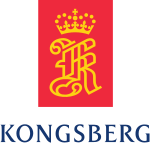Kongsberg Gruppen
 | |
| Type | Public |
|---|---|
| Industry | Military and maritime systems |
| Founded | 1814 |
| Headquarters | Kongsberg, Norway |
| Area served | Global |
| Key people | Walter Qvam (CEO) |
| Revenue |
|
| Net income |
|
| Employees | 7,259 (December 2012) |
| Subsidiaries |
Kongsberg Maritime Kongsberg Defence Systems Kongsberg Protech Systems Kongsberg Oil & Gas Technologies |
| Website | http://www.kongsberg.com |
Kongsberg Gruppen (OSE: KOG) (lit.: "The Kongsberg Group") is a Norwegian defence contractor[2] and maritime automation supplier,[3] located in Kongsberg, a former mining town.
KOG consists of four business areas, Kongsberg Defence Systems (KDS), Kongsberg Protech Systems (KPS), Kongsberg Oil & Gas Technologies (KOGT) and Kongsberg Maritime (KM). KDS is a supplier of defence and aerospace-related systems and KPS delivers weapon control systems with PROTECTOR Remote Weapon Station. KOGT provides technology, products and services for surveillance, integration, analysis, simulation, quality assurance, and governance of drilling and production operations and KM delivers products and systems for positioning, navigation and automation to merchant vessels and offshore installations, as well as products and systems for seabed surveying and monitoring, and for fishing vessels and fisheries research. KM also delivers training programmes for its products worldwide.[4]
History
The company was established March 20th in 1814 as Kongsberg Vaabenfabrik (KV) (lit.: "Kongsberg Weapons Factory"), a name which remained virtually unchanged until 1987, when it took the name Norsk Forsvarsteknologi (NFT) (lit.: "Norwegian Defence Technology") after restructuring due to the sale of all civilian activity and financial troubles. The name changed again in 1995 to the present Kongsberg Gruppen following its listing on the Oslo Stock Exchange in 1993. In 1974, a Canadian subsidiary known as Kongsberg Mesotech Ltd was established for the development and manufacturing of underwater surveillance systems.
In 1987, the company was part of the Toshiba-Kongsberg scandal, which involved a subsidiary of Toshiba and the Kongsberg Vaapenfabrikk. The two provided the Soviet Union with technology (Toshiba milling machines and Kongsberg computer numerical controls) that could be used to produce quiet submarine propellers, in violation of the CoCom agreement. The US always relied on the fact that the Soviets had noisy boats. Providing the USSR with technology that could make their subs harder to find and track was perceived as a significant threat to America's security.
References
See also
- CROWS
- Kongsberg Colt
- Krag-Jørgensen
- Kongsberg Spacetec
- List of oldest companies
- M1 Abrams TUSK Kit (M1 Abrams tank with Kongsberg Gruppen remote-control MG turret)
External links
- Corporate website
- Kongsberg Maritime
- Kongsberg Defence Systems
- Kongsberg Protech Systems
- Kongsberg Oil & Gas Technologies